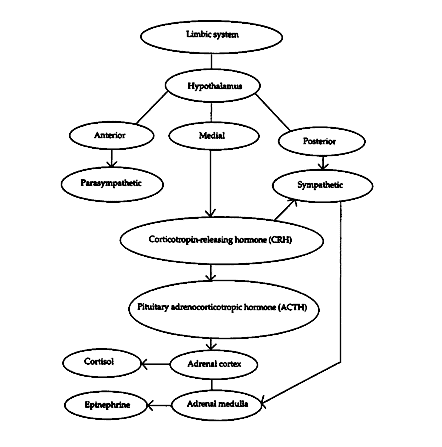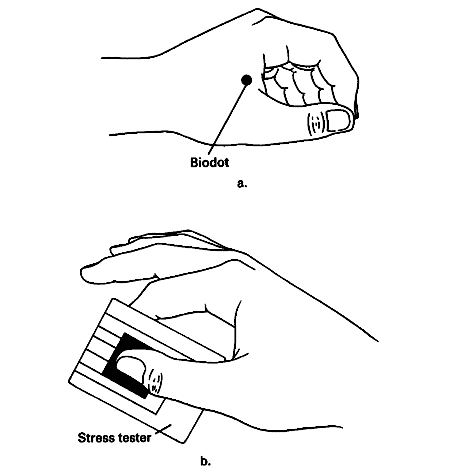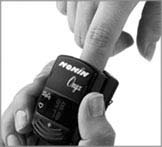Stress
The nervous system regulates the homeostasis of the body either directly by sending messages to various parts of the body, or indirectly by relaying them via the hypothalamus, the pituitary gland, and other endocrine organs. Reaction to stress is particularly complex and affects many physiological mechanisms. Selye (1974), the researcher who first used the term "stress," called stress the "non-specific response of the body to any demand." The stress reaction helps the body deal with stimuli perceived as a threat, or it can contribute to peak performance during an athletic or intellectual task. This response to stress requires that large amounts of stored energy be released quickly. Overall, this response is an inefficient use of the body's energy, as the body must use energy to regain a homeostatic state and replenish the depleted stores of energy. Even with ample supplies of energy, the ability to resist chronic or prolonged stress will diminish until a state of exhaustion occurs.
Stimuli come from two general areas--peripheral nerves and the brain--to activate the stress response system of the body. Environmental stimuli that cause pain, an allergic reaction, or an internal stimulus caused by a drastic fall in blood pressure send messages over peripheral sensory nerves to the midbrain. From the midbrain, the messages pass to the thalamus located deep within the brain's core. The thalamus relays sensory information to the hypothalamus located below it, and to the cortex of the brain, as shown in Figure 1.
The second source of stimuli is from the brain. Fear or anxiety may occur when one perceives situations similar to previous unpleasant experiences. The prospect of a pop quiz is an example that is incorporated into this activity. In this case, anxiety stimulates messages to be sent from the cortex and limbic system to the hypothalamus. The response to stress varies with the individual's age, gender, and genetic makeup. Environmental factors, such as diet, drugs, and temperature extremes, also influence the response to stress.
The hypothalamus is powerful because it is the meeting place for the body's two control networks: the nervous system that exerts control via electrical messages through the nerves to release chemical neurotransmitters and the endocrine system that sends chemical messengers called hormones through the blood to act on organs directly. The hypothalamus coordinates the stress response by releasing corticotropin-releasing hormone (CRH). Recent evidence shows that CRH is released also as a neurotransmitter. CRH was discovered first as a hormone, hence its name. As a hormone, CRH controls the pituitary and the cortex of the adrenal gland. As a neurotransmitter, CRH controls behavior in higher brain centers and also appears to control the autonomic nervous system. The hypothalamus receives messages from peripheral nerves, the cortex, and the limbic system, and sends messages out that induce the body's three characteristic types of response to stress: behavior, autonomic nervous system, and endocrine system.
The behavioral responses to stress are numerous, complex, and only partially understood. One behavioral response is nervous eating. Another is alternately freezing and running in the face of danger. In the classroom, nervous behavior may occur when a pop quiz is announced. The message enters the ears and goes to the cortex and limbic system where it is recognized as a cause for concern, especially if one has not studied. From here, the message is sent to the hypothalamus that returns messages to the limbic system to stimulate complex behavioral patterns, such as fidgeting, tremors, and increased talkativeness. One of the hypothalamic messages is CRH, the same chemical that stimulates the endocrine and autonomic nervous systems. Consequently, students may also experience the autonomic symptoms of dilated pupils, sweaty palms, and increased heart and respiratory rates. The hypothalamus uses CRH as one of its messengers to coordinate the stress response to the pop quiz.
A second type of response stimulated by the hypothalamus is the autonomic nervous system. The autonomic responses are often the easiest to identify and may include increased heartbeat, breathing, and the passage of food through the body; contraction of the bladder and the gut; and the influence of sweating and shivering on body temperature. The autonomic nerves send their messages to organs and glands by the sympathetic and the parasympathetic systems. These two pathways counterbalance each other, keeping the body in a steady state. The motor neurons in these systems are located outside the central nervous system (CNS) in small encapsulated clusters called ganglia
Most of the autonomic nerve activity in the stress response is due to sympathetic nerves that release the neurotransmitter norepinephrine. Action of the parasympathetic system tends to restore the body to its state prior to the stressful stimulus (see Table 1).
The third type of response stimulated by the hypothalamus occurs in the endocrine system. In reaction to continued stress, the hypothalamus secretes CRH and thyrotropin-releasing hormone (TRH). These hormones are carried to the pituitary gland through the blood vessels of the pituitary stalk that connects the hypothalamus and the pituitary. See Figure 3.
CRH and TRH stimulate the anterior pituitary to release two additional hormones into the blood of the systemic circulation. CRH stimulates the adrenocorticotropic hormone (ACTH) and TRH stimulates thyroid-stimulating hormone (TSH) release. ACTH stimulates the outer layer of the adrenal gland, called the adrenal cortex, to release cortisol. Cortisol stimulates the body's cells to use fat and protein, rather than glucose, for evergy . TSH stimulates the thyroid gland to release the hormone thyroxine. Thyroxine stimulates the cells of the body to use glucose at a faster rate. Together cortisol and thyroxine help to supply energy to cells that are stimulated by stress stimuli and to cope with the increased metabolic demands on the cells brought on by increased activity.

All three stress response systems -- behavior, autonomic, and endocrine -- are coordinated in part by the hypothalamic release of CRH. These systems work together to help the body work at peak performance during athletically, intellectually, physiologically, or emotionally stressful activities. Acute stress is generally seen as beneficial in this way. However, during prolonged stress, the stress response may damage certain body tissues and functions. Cortisol acts as a negative feedback mechanism to prevent overreaction of the several CRH-stimulated stress response systems. This is fairly effective with acute stress, but long-term or chronic stress is still associated with harmful effects. It is generally best if one can manage a lifestyle with intermittent acute stress rather than continuous stress.
Objectives:
1. Observe, measure and record body responses to various stressful situations.
2. Describe the role of the nervous system in the stress response and its relationship to the endocrine system.
3. Analyze data regarding the effects of stress on human behavior and physiology.
Materials:
Group Materials:
- watch/clock with second timer
- temperture sensor
- thermometer
- metric ruler
- Nonin Pulse Oximeter
- blood pressure monitor
- Glucose monitor
Behavioral Stress Activity
Methods:
Work in groups of three. Obtain a temperature sensor with a color indicator.
- Attach it to the tops of your hands, as shown below, if using the "BiodotTM" sensor, or
- Hold it between your thumbs and index fingers, as shown in below, if using the "Stress TesterTM"

Record the temperature from the sensor.
Obtain pulse rate and pO2 with the Nonin Pulse Oximeter as shown below.

Follow these instructions:
- Place the sensors at the tops of your desks.
- Place all books and notes under their desks or away and out of sight.
- Wait for further instructions.
Place the sensors again as you had them before, either on top of your hands, or between your thumbs and index fingers. After 15 seconds, write the color on the sensor next to number one. After 15 seconds, record the color of the sensor beside number 2.
Devise ways to elicit three additional color changes on the sensor and record the event and color of the sensor on numbers 3 to 5.
Results
Table 1 - Behavior Stress Activity
|
Event |
Event Description |
Temperature |
HR |
pO2 |
Glucose |
|
baseline |
baseline |
|
|
|
|
|
1 |
|
|
|
|
|
|
2 |
|
|
|
|
|
|
3 |
|
|
|
|
|
|
4 |
|
|
|
|
|
|
5 |
|
|
|
|
|
Discussion
- What causes the sensor to change color? Does this have any relationship to the physiology of the body? If so, explain.
- What physiological changes are the stress sensors measuring?
- Does a relationship exist between the color of the sensor and the event that occurred?
- Are the color changes for each event consistent for all members of the class? Why or why not?
Physical Stress Activity
Methods:
Work in groups of three. Obtain pulse rate and pO2 with the Nonin Pulse Oximeter as shown below.

Measure Blood Glucose using a drop of blood from a finger prick and a blood glucose monitor Establish baseline pulse, pO2, and glucose.
The subject should run in place for three minutes, then the pulse recorder should take the pulse again. The time keeper should record this rate.
Results
Table 2 - Physical Stress Activity
|
Event Description |
pulse rate |
pO2 |
Glucose |
|
baseline |
|
|
|
|
immediately after running |
|
|
|
|
ten minutes after running |
|
|
|
Discussion
- Why does your heart beat faster when you get excited?
- Why do your hands sweat when you are afraid or nervous?
- Why do you breathe faster when you are angry?
- How do you feel when you are under pressure?
- What systems of the body react to help protect you from danger?
- How would those systems change during this time, and after the danger had passed?
- State in words how stimulation of the sympathetic system affects all of the organs in the diagram at the same time, because fibers from different segments of the spinal cord innervate all the body systems simultaneously.
- What parts of your body are activated in times of danger?
- How does the nervous system affect the parts of the body?
- What parts of the nervous system are involved in the stress response?
© David G. Ward, Ph.D. Last modified by wardd 23 May, 2006